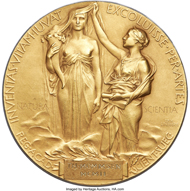by Björn Schöpe
translated by Annika Backe
December 14, 2017 – Heritage was proud to offer one of the oldest Nobel Prize medals (we reported). In New York on January 6, 2018, the medal was to be sold at auction which, in 1902, had been awarded to the German expert on Ancient History, Theodor Mommsen for his literary achievements, in particular for his “History of Rome”.
This medal was to be offered at the Heritage auction.
It is the oldest Nobel Prize medal in Literature (in the first year, 1901, no medal had been awarded in that category yet), as one of the very few awarded for non-fiction up until the present day, and probably the oldest Nobel Prize medal that has been available at auction so far. The expected proceeds of $400,000 seemed to be a realistic estimate.
The original medal, housed in the German Literature Archive Marbach. Photo: Chris Korner/DLA Marbach.
But then the thunderbolt: Mommsen’s medal has been kept in the air-conditioned rooms of the German Literature Archive Marbach for 14 years now. The great-grandson of Theodor Mommsen, Peter Mommsen had given it to the Archive at that time. According to an article in the “Südkurier” news magazine, Mommsen demanded that the institution made it clear that “their foundation assets will not be sold”. The donor told the newspaper: “The Mommsen family is in consternation by this audacity to try bringing a fake medal onto the market – on the occasion of Theodor Mommsen’s 200th birthday, of all dates.”
Things are not quite as straightforward as that, however. Heritage immediately withdrew the item from the auction and checked it. The experts of the auction house and the Nobel Prize Foundation reached the preliminary conclusion that the medal is in fact a real Nobel Prize medal.
Since the medal for the Nobel Prize in Literature had not yet been ready in 1901, Mommsen received the first medal, created by Erik Lindberg, the following year. Since then, the motif has remained unchanged and still features a young man writing and probably a muse holding a lyre. This is what the Marbach medal looks like. The piece offered by Heritage, on the other hand, is totally different.
A personification of nature rises from the clouds, next to it there is the genius of science. The words “scientia” (science) and “natura” (nature) refer to the natural sciences. This motif, also designed by Erik Lindberg, can only be found on Nobel Prize medals awarded for achievements in Physics and Chemistry.
The genuine Mommsen medal in Marbach. Photo: Chris Korner/DLA Marbach.
It is undisputable that the genuine Mommsen medal is being kept in Marbach. What is unclear, on the other hand, is why Mommsen’s name appears on the medal offered by Heritage. The “Südkurier” suspected that if the piece was not a fake, it might be one of those cock-and-bull-stories, meaning in this case: a mis-strike that was replaced once, disappeared and then turned up again …
Numismatic literature yields more thoroughly researched information on this. In his 2001 catalog of Nobel Prize medals, Lars O. Lagerquist remarked: “Furthermore, a number of medals were struck in silver and in silver gilt at an early stage for museums and collectors (possibly only in 1902, nowadays it is forbidden).” Perhaps gold medals were also made back then, and none of them have yet become known. So, there is a slight chance after all that this is actually a product of the time, even if it is none of those which Mommsen himself held in his hands.
Anyway, the fact remains: currently, we do not know in what context the medal was produced and why it mentions Mommsen’s name. Heritage Auctions spokesman Eric Bradley commented on the incident: “Although this piece is indeed a real Nobel Prize gold medal, Heritage Auctions has determined the award is not the one bestowed to Theodor Mommsen. Unlike most auction houses, Heritage Auctions routinely posts each lot in our online previews sections at www.HA.com prior to finalizing our auction catalogs, usually as soon as the objects are photographed and cataloged. This policy allows the collecting and dealer community extra time to review and even help us vet upcoming items for auction. In this case, thanks to the vigilance of our clientele and others, we were able to remove the medal in question from our auction before the auction catalog was even published. We vet hundreds of thousands of items a year and it is common that some are not exactly what they are purported to be. Once we find something to be misrepresented we act immediately to correct it and Heritage Auctions immediately removed the lot from the upcoming auction. We continue to look into this medal and it will be returned to the current owner.”
The incident illustrates two things: it is possible that particularly a huge amount of material consigned includes an object which will then be removed for good reasons. And, secondly: Heritage is acting in exemplary fashion because it makes the lots publicly known at an early stage and responds swiftly to information.
It remains to be seen whether the medal is a deliberate counterfeit, as Peter Mommsen suspects, or whether the background is more complex. It is clear, though, that sound provenance research is important, even if that may take some time.
Although collectors should not set their hope on getting Mommsen’s medal, there could be an exciting story behind this piece. We can be curious then.
To go the Heritage Auctions website, click here.
To learn more about Theodor Mommsen’s medals, read this article on our German site MünzenWoche.
Accompanying the Tübingen exhibition there is an online catalog available. There you find everything on “Mommsen on medals and plaques”, as well as detailed information on Mommsen’s Nobel Prize medal on pages 19 and 20.
A comprehensive article has been published in the German news magazine Südkurier.








